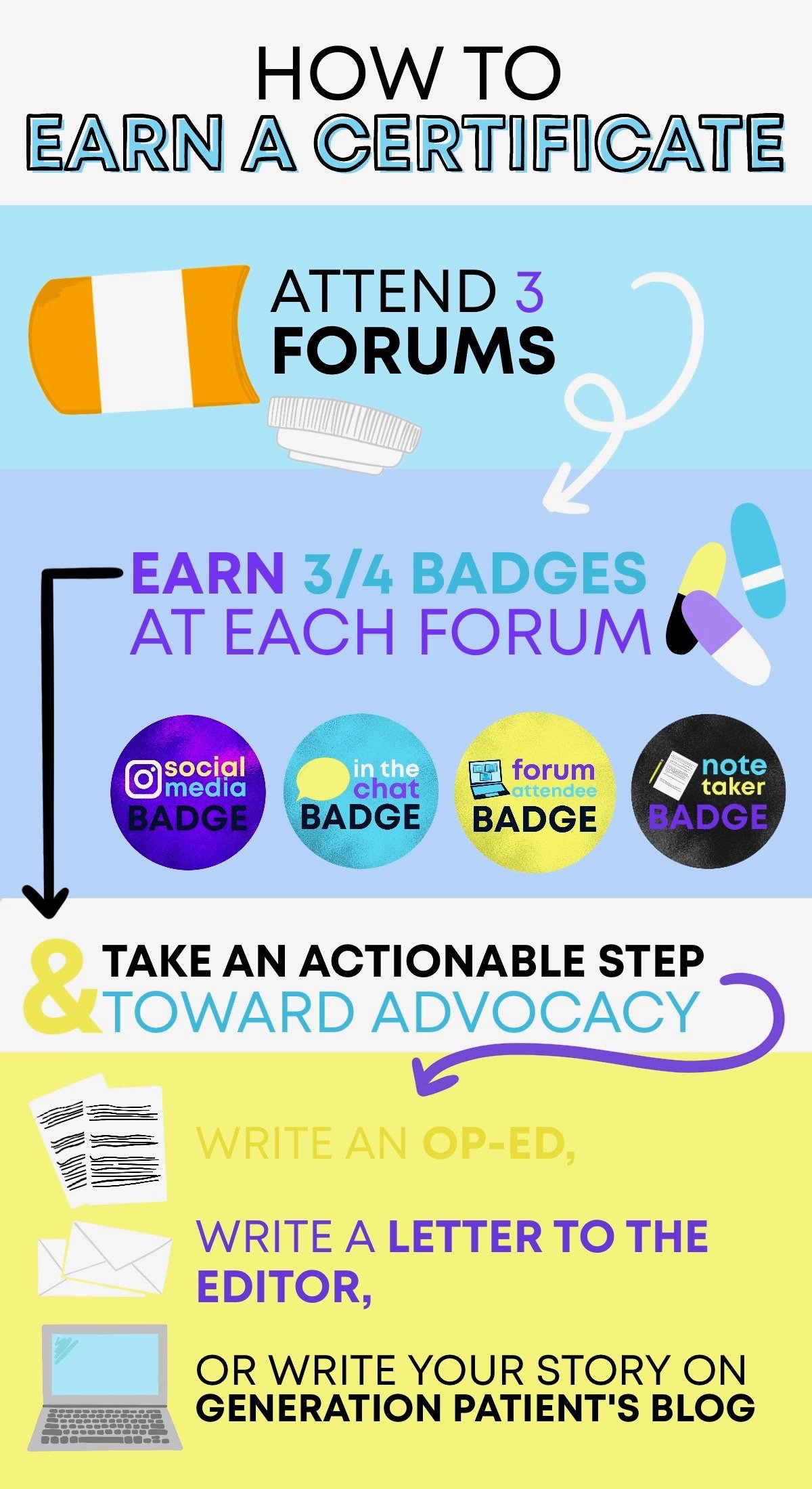Dear Chair Murray and Ranking Member Burr,
Generation Patient is a nonprofit focused on empowering the next generation of patients, led entirely by young adults with chronic and rare conditions. Our work has touched regions across the country. Through our nonpartisan and focused initiatives—the Health Policy Lab and the Crohn’s and Colitis Young Adults Network —we work to increase the health literacy, confidence, self-management skills, public policy knowledge, and advocacy strategies of young adult patients. We have developed programming related to navigating the higher education landscape as well as educating people about health policy with independent research and analysis. Additionally, we have facilitated more than 250 virtual meetings during the past two years focused on connecting young adult patients around the world and providing them with critical peer support.
As one of the very few industry-independent patient advocacy nonprofits, we want to emphasize that the following requested revisions are critical to us as patients diagnosed entering adulthood with lifelong chronic medical conditions. We are grateful for the opportunity to provide feedback on legislation that will directly impact us.
Clinical Trial Diversity
Over 85% of young people with chronic conditions are now surviving into adulthood, many of whom live with complex, lifelong conditions.1 Young adulthood is a pivotal time of transition and growth and is an area that needs extended investigation and representation within clinical trials. Ethical research of young people should focus on two goals: protection from research risk and appropriate inclusion in clinical research that will improve our understanding of therapeutics.2 User fee agreements should include narrow age reporting requirements in clinical trial applications and post-market activities. Any legislation pertaining to clinical trial diversity must explicitly include developmentally age-appropriate clinical trial stratification. For above 18, we suggest 18-26 and as separate age categories and 27-35. Age must also include the further intersection of underrepresented minorities.
The ages of participants in clinical trials should be made clear and should be representative of the patient population for the chronic condition. The young adult population must be proactively included as are adults within clinical trials. As more of us are diagnosed at younger ages, it is imperative that young adult patients are represented within all aspects of clinical research. It is unreasonable to assume similar efficacy and safety of an intervention on young adult patients who are underrepresented in testing for this intervention.
Furthermore, age should be an included factor as is race, ethnicity, and other critical areas of diversity. We recommend the inclusion of takeaways from the recently launched “Improving the Representation of Women and Underrepresented Minorities in Clinical Trials and Research” to further include the urgent necessity of including underrepresented minorities in clinical research.3 In addition, it is imperative that the public is aware of any diversity plans from medical sponsors in a timely manner.
Adverse Event Reporting
Language in the legislation focusing on updating and developing better adverse event reporting mechanisms must be expanded upon. Per the current FDA Adverse Event Reporting System (FAERS) dashboard, 18-year-olds and 64-year-olds are included in the same category. There is a massive physical difference between an 18-year-old and a 64-year-old. We recommend changing FAERS to 18-26 years old and 27-35 years old to better capture unique developmental periods. Young adult patients must be treated substantially differently than adults or older adults and must be recognized as an individual age demographic. More attention should be emphasized to adverse event reporting as it pertains to age-specificity.
Pharma Direct-to-Consumer-Advertising on Social Media
The legislation should include a section on direct-to-consumer advertising (DTCA) of medical products, particularly on social media. At the very least, the legislation should include that the FDA should issue guidance on the emergence of pharma DTCA on social media, particularly TikTok and Instagram. Given that younger people are utilizing social media more often, there must be greater discretion on the ways that prescription drugs are being advertised on these channels. The largest age group using Instagram is aged 25-34 at 31.2% and the ages of 18-24 at 31%. On TikTok, the largest age demographic of users is 10-19.4 There are many challenges with DTCA, for example, the unregulated comment sections of prescription drug advertisements and the lack of clear and distinguishable advertisement disclosure. Additionally, micro-influencers (accounts with around 10,000-50,000 followers) on social media appear to be an emerging avenue through which pharmaceutical companies promote their prescription drugs, using their smaller platform and more authentic point of view to appeal to their audience. The industry clearly recognizes the power of these influencers, particularly on the Generation Z patient demographic, and the FDA must catch up to the speed at which the industry is adapting various outlets. In summary, we suggest the following as it pertains to pharmaceutical social media DTCA.
The FDA should work with patients and influencers to issue updated guidance on specifically pharma DTCA within social media. More oversight and research are necessary for social media DTCA.
The FDA should host an updated public hearing about pharma DTCA in conjunction with the FTC and the public, including independent stakeholders.
The Office of Prescription Drug Promotion should conduct studies like this and this to extend to the impact of pharma DTCA on social media.
Social media has a large influence on users and thus must be identified as an urgent and emerging pathway that the FDA should proactively investigate as it pertains to prescription drugs.
Thank you for the opportunity to submit feedback and we look forward to collaborating on these urgent issues impacting our patient community.
Sincerely,
Generation Patient
Citations
1. Yeo M, Sawyer S. Chronic illness and disability. BMJ 2005;330(7493):721-3. DOI: 10.1136/bmj.330.7493.721.
2. Kapogiannis BG, Mattison DR. Adolescents in clinical trials. Clin Pharmacol Ther 2008;84(6):655-9. DOI: 10.1038/clpt.2008.191.
3. National Academies of Sciences E, Medicine. Improving Representation in Clinical Trials and Research: Building Research Equity for Women and Underrepresented Groups. 2022.
4. Barnhart B. Social media demographics to inform your brand’s strategy in 2022


















